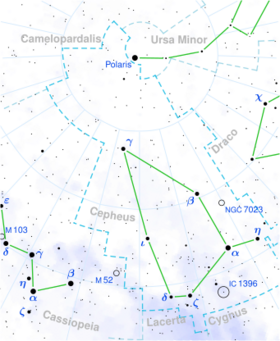Astronomy:Zeta Cephei
| Observation data Equinox J2000.0]] (ICRS) | |
|---|---|
| Constellation | Cepheus |
| Right ascension | 22h 10m 51.279s[1] |
| Declination | +58° 12′ 04.53″[1] |
| Apparent magnitude (V) | 3.35[2] |
| Characteristics | |
| Spectral type | K1.5 Ib[3] |
| Variable type | Eclipsing binary?[4] |
| Astrometry | |
| Proper motion (μ) | RA: 12.654 ± 0.4618[1] mas/yr Dec.: 5.989 ± 0.835[1] mas/yr |
| Parallax (π) | 3.2972 ± 0.1456[5] mas |
| Distance | 990 ± 40 ly (300 ± 10 pc) |
| Absolute magnitude (MV) | −4.7[6] |
| Details | |
| Radius | 94[7] R☉ |
| Luminosity | 2,228 - 2,249[7] L☉ |
| Surface gravity (log g) | 0.75[8] cgs |
| Temperature | 4,072±170[7] K |
| Metallicity [Fe/H] | +0.22[8] dex |
| Rotational velocity (v sin i) | 10.64[9] km/s |
| Other designations | |
| Database references | |
| SIMBAD | data |
Zeta Cephei (ζ Cep, ζ Cephei) is a star in the constellation of Cepheus. Zeta Cephei marks the left shoulder of Cepheus, the King of Joppa (Ethiopia).[clarification needed] It is one of the fundamental stars of the MK spectral sequence, defined as type K1.5 Ib.
Zeta Cephei is a red supergiant star with a surface temperature of 3,853 K and eight times more massive than the Sun. The luminosity of Zeta Cephei is approximately 3,600 times that of the Sun. At a distance of about 840 light-years,[10] Zeta Cephei has an apparent magnitude (m) of 3.4 and an absolute magnitude (M) of -4.7. The star has a metallicity approximately 1.6 times that of the Sun; i.e., it contains 1.6 times as much heavy-element material as the Sun.
Hekker et al. (2008) have detected a periodicity of 533 days, hinting at the possible presence of an as yet unseen companion.[11] It is listed as a possible eclipsing binary with a very small amplitude.[4]
At the edge of the 8 to 10 solar mass (M☉) limit at which stars develop iron cores and then explode as supernovae, Zeta Cephei's most likely fate is to produce a very massive white dwarf near the Chandrasekhar limit (1.4 M☉) at which such dense remnants can survive. If Zeta Cephei is a binary star; i.e., if there is a stellar companion, and it is close enough to feed sufficient matter to the white-dwarf-to-be, it is marginally possible that the limit could be overflowed, resulting in the white dwarf's collapse and a Type Ia supernova explosion.[citation needed]
References
- ↑ 1.0 1.1 1.2 1.3 Brown, A. G. A. (August 2018). "Gaia Data Release 2: Summary of the contents and survey properties". Astronomy & Astrophysics 616: A1. doi:10.1051/0004-6361/201833051. Bibcode: 2018A&A...616A...1G. Gaia DR2 record for this source at VizieR.
- ↑ Cite error: Invalid
<ref>tag; no text was provided for refs namedcool - ↑ Morgan, W. W.; Keenan, P. C. (1973). "Spectral Classification". Annual Review of Astronomy and Astrophysics 11: 29–50. doi:10.1146/annurev.aa.11.090173.000333. Bibcode: 1973ARA&A..11...29M.
- ↑ 4.0 4.1 Samus, N. N. et al. (2009). "VizieR Online Data Catalog: General Catalogue of Variable Stars (Samus+ 2007–2013)". VizieR On-line Data Catalog: B/GCVS. Originally Published in: 2009yCat....102025S 1: 02025. Bibcode: 2009yCat....102025S.
- ↑ Brown, A. G. A. (2021). "Gaia Early Data Release 3: Summary of the contents and survey properties". Astronomy & Astrophysics 649: A1. doi:10.1051/0004-6361/202039657. Bibcode: 2021A&A...649A...1G. Gaia EDR3 record for this source at VizieR.
- ↑ Luck, R. E. (1982). "The chemical composition of late-type supergiants. IV - Homogeneous abundances and galactic metallicity trends". Astrophysical Journal 256: 177. doi:10.1086/159895. Bibcode: 1982ApJ...256..177L.
- ↑ 7.0 7.1 7.2 Messineo, M.; Brown, A. G. A. (2019). "A Catalog of Known Galactic K-M Stars of Class I Candidate Red Supergiants in Gaia DR2". The Astronomical Journal 158 (1): 20. doi:10.3847/1538-3881/ab1cbd. Bibcode: 2019AJ....158...20M.
- ↑ 8.0 8.1 Mallik, Sushma V. (December 1999), "Lithium abundance and mass", Astronomy and Astrophysics 352: 495–507, Bibcode: 1999A&A...352..495M
- ↑ Hekker, S.; Meléndez, J. (2007). "Precise radial velocities of giant stars. III. Spectroscopic stellar parameters". Astronomy and Astrophysics 475 (3): 1003. doi:10.1051/0004-6361:20078233. Bibcode: 2007A&A...475.1003H.
- ↑ van Leeuwen, F. (2007). "Validation of the new Hipparcos reduction". Astronomy and Astrophysics 474 (2): 653–664. doi:10.1051/0004-6361:20078357. Bibcode: 2007A&A...474..653V. http://www.aanda.org/articles/aa/full/2007/41/aa8357-07/aa8357-07.html.Vizier catalog entry
- ↑ Hekker (2008). "Precise radial velocities of giant stars. IV. A correlation between surface gravity and radial velocity variation and a statistical investigation of companion properties". Astronomy and Astrophysics 480 (1): 215–222. doi:10.1051/0004-6361:20078321. Bibcode: 2008A&A...480..215H.
 |


